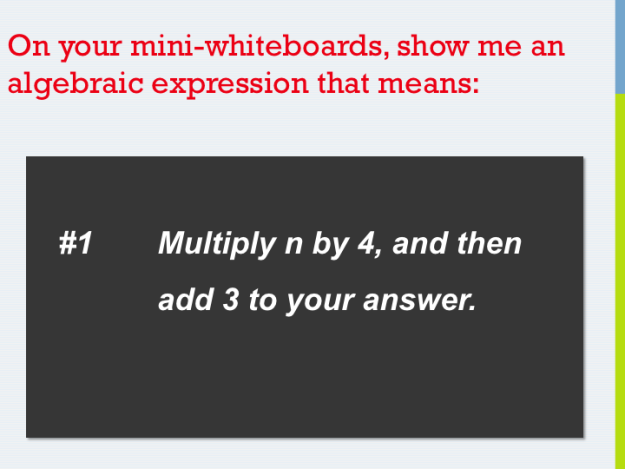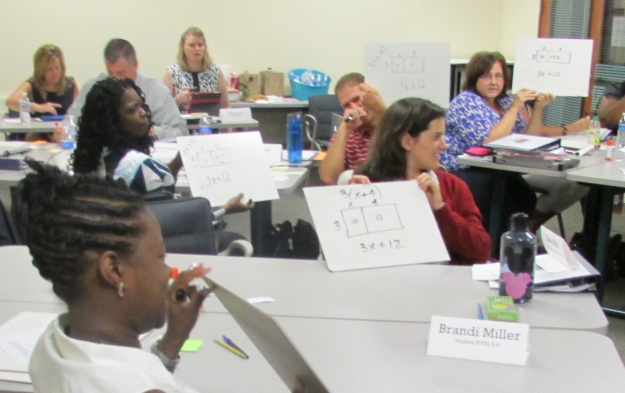The classroom is busy. Questions, answers, even laughter fill a space at Metro Early College in Columbus, Ohio. But the members of the class aren’t students, at least not most of the time. Instead, they’re teachers from some of Ohio’s most innovative schools – joined together through the Ohio STEM Learning Network, an organization founded in 2007 with help from Battelle and other supporters of STEM education.
For the last two days, these teachers have taken on the character of eighth grade math students. They’re playing this role to get some first-hand experience with a new way of teaching math, developed by the Mathematics Design Collaborative.
The two coaches for the training are, Margie Belair and Jessica Rudolph. Both are teachers at STEM schools here in Columbus. They’ve both also made the switch to the Mathematics Design Collaborative method in their own classes. In one early exercise, Jessica and Margie, started a lesson on algebraic expressions. If Algebra is a distant memory for you, here’s a sample algebraic expression: (5n)2
In most math classes, the first part of any lesson starts with the teacher defining the concept then working through a few sample problems in front of the class. He questions then maps out a path to the right the answer.
Margie and Jessica’s lesson begins with a quiz. Not a quiz on a lesson covered last week in class, but a quiz on the lesson they’re about to teach. Sound frustrating? But this “assessment task” reveals a critical piece of information: where students actually are on this subject and at this point in time.
In a real classroom Margie and Jessica would collect the quizzes, evaluate them and use that information to guide their plan for the entire lesson. Given that the “students” in this demonstration are all teachers, they skip to step two.
They put up algebraic problems on a screen at the front of the class. Like this one: Multiply n by four, and then add three to your answer.

The class responds by jotting answers on their whiteboards. At Jessica’s request, each student holds up her board.

Jessica scans them. And here’s where things get interesting. She calls on a student and asks, “Can you explain your answer to the class?” She responds. Jessica calls on an another, “How did you get your answer?” A third.
Sometimes she asks clarifying questions: “What’s that symbol you used?” “How do you know that answer works?”
There’s one thing she never says: “That’s right.” In fact, neither Jessica nor Margie supply a single answer. Why? Because there is no single answer. There’s a set of them. While most boards in the room show similar ones, there are usually at least two different approaches. Sometimes more. And that’s no accident.
Unearthing those different paths is a key goal of this teaching method. It’s also one that the teachers love. Sandra Wilder, one of the trainees, said later, “A lot of mathematics teachers think very linear. For a long time, we were so focused on getting that answer that we completely forgot how we learn. (This method) takes our focus back on teaching and learning.”
What about when a student takes an approach that isn’t just different, it’s wrong? One of her trainees presses for an answer about whether Jessica or Margie would correct a wrong answer during this exercise. Jessica responds that she tries to avoid it whenever possible. Instead, she suggest tactics like:
- Test two different formulas submitted by the class by having the students plug in actual figures for the variables. Then, when the results don’t match, students can start to work out what went wrong.
- Ask the student with the wrong answer to compare his answer with that of other students.
- Have two students put their different answers up on a poster to return to later in the lesson.
The method developed by the Mathematics Design Collaborative is built to surface how students actually think about the concepts. By voicing their own thinking, including misconceptions, students can talk the problem out. That helps them figure out language and methods for math that work for them, not just their classmates.
In the next phase of the lesson, students work in pairs on joint activity. Pairs are designed using information the teacher collected on student approaches from the quiz. In this lesson on algebraic expressions, students are given tasks requiring them to translate between words, symbols, tables, and spatial representations of expressions. The students are responsible for listening and making sense of each other’s approaches and sharing and justifying their own approach. The teacher continues to ask for explanations – not answers.
The lesson concludes with a post lesson assessment – to gauge student growth and to inform what happens next.
“MDC (as the method is known by educators) is something that I personally will try in my classroom,” said Sandra. Formerly a teacher education faculty member at the University of Akron, Sandra has thought a lot about how teachers should approach new instructional programs. Now, as a teacher at the new BioMed Science Academy in Rootstown, she’s focused on finding tools that help her and her colleagues reach students more effectively.
“What sold me…(is that) the content aligns with the Common Core State Standards…(but it also) aligns with mathematical practice,” said Sandra. “As teachers, we can’t be that quick to just adopt something… (but) MDC isn’t an instructional method. It’s creating a learning environment where teachers and students work together. It can be something that we do.”
Interested in learning more about how you can get MDC into your classroom? Sign up here for updates about trainings in your area.